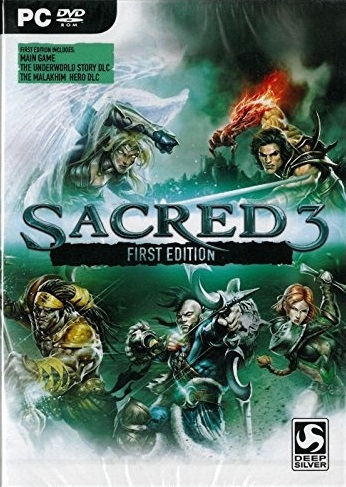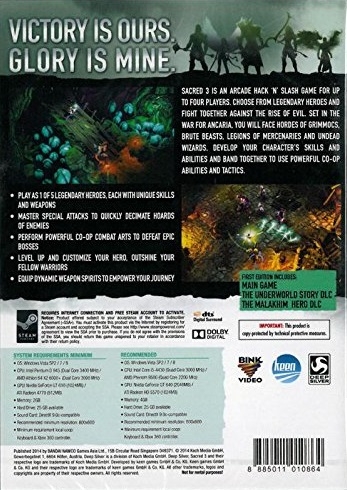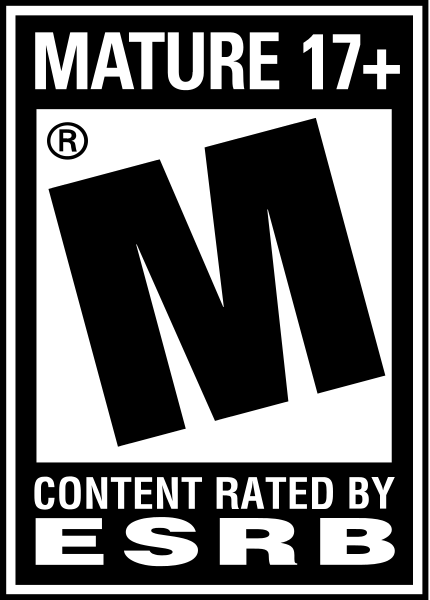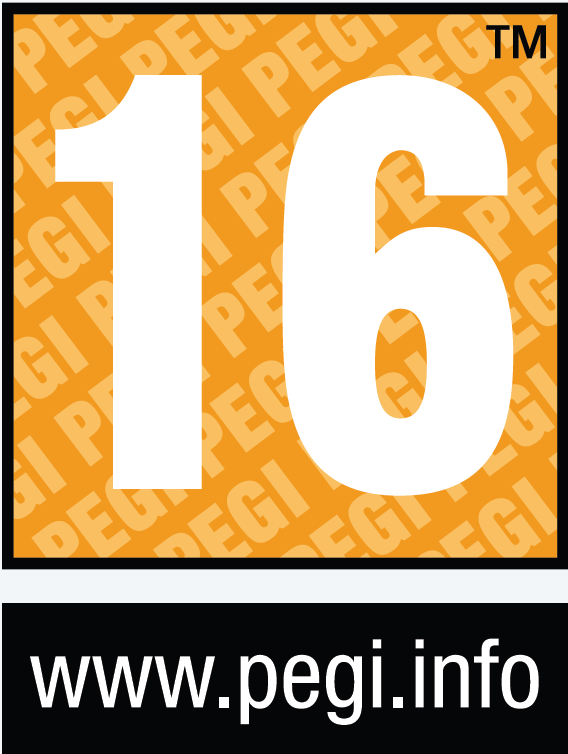Existing User Log In
New User Registration
Register for a free account to gain full access to the VGChartz Network and join our thriving community.





America - Front


America - Back



Keen Games
Role-Playing
 07/29/14 Deep Silver
07/29/14 Deep Silver  (Add Date)
(Add Date) 08/01/14 Deep Silver
08/01/14 Deep Silver
| Owners: | 0 |
| Favorite: | 0 |
| Tracked: | 0 |
| Wishlist: | 0 |
| Now Playing: | 0 |
The Sacred series spawned during a time in the early 2000s when Diablo clones ran amok; a new action RPG fuelled by loot drops and branching character trees was seemingly released once a month. Sacred 2, despite its massive amount of technical problems, brought the action RPG loot-fest to the 360 and PS3, providing countless hours of open world fun and proving that the genre can in fact work extremely well on consoles. Now, nearly six years later and following a failed attempt at the side-scrolling brawler RPG in Sacred Citadel, Sacred 3 hopes to right the ship by bringing the series back to its ARPG roots in a streamlined fashion. Yet streamlining and simplicity have a very fine line between them, and Sacred 3 often finds itself on the wrong side.
Sacred Citadel was intended both as a prequel to, and companion for, Sacred 3, serving to (re)introduce the world of Ancaria and its inhabitants, as well as set-up the narrative direction the game would take. After many delays, which saw an initial release date of 2013 turn into the summer of 2014, the narrative effect of Sacred Citadel was lost, though that's notto say it would have actually improved the plot of Sacred 3. The story is rather simple, as warriors from all around Ancaria are gathered to combat the evil Ashen Empire ruled by Lord Zane, who has been able to combat Ancaria's forces thanks to the citizens all but forgetting about the powerful Seraphim (angels, essentially) that once protected the land.
To make matters worse, Zane gets his hands on the Heart of Ancaria, a legendary artifact that holds indescribable power, and it's up to a small group of warriors to retrieve the artifact and put an end to Lord Zane and the Ashen Empire. Cutscenes are depicted through motion comics that lack much movement, and Sacred's brand of quirky and campy humor highlights the overall feel of the story; it's like an 80's cartoon, without the nostalgia factor. Events are entirely predictable, serious parts are underplayed in favor of attempted humor, and you know that at the end of the game, like any 80s Ninja Turtle, Transformers or GI Joe episode, our heroes will come out on top. Sacred 3's humor hinges upon the polarizing campiness of character interactions, with most of the comic "relief" coming from a single character that feeds you information during missions and cutscenes. While some may find her entertaining, others will quickly realize that she is utterly annoying, wishing they could mute her for the entirety of the game.
When I read or hear the term action RPG, my mind immediately begins thinking about massive loot drops, hordes of monsters, and multi-level dungeons or an open-world to explore. However, Sacred 3, in its "streamlined" form, seems to be missing some key elements. Rather than a hub city or an explorable overworld, the game plays out through a series of different missions that are linked together by uninteresting cutscenes. Loot is completely absent, with gold and health and magic orbs being the only rewards that drop from enemies besides bosses. Abilities are acquired and strengthened by using gold, which is plentiful and never an issue when it's time to increase the level of your skills. Since there is no loot to collect, equipment is limited to a piece of armor, as well as a small handful of weapons that are leveled in the same way as abilities. Instead of improving upon the formula established in the first two games, Sacred 3 has stripped it down to the point where the game no longer feels like an action RPG, but a top-down brawler with some role playing elements; it has more of a connection with the Sacred Citadel spin-off than with the other core games of the series.
Diving into the action, it's rather apparent that the PC version of Sacred 3 is merely a port of the console versions, as the game feels much more natural when using a controller due to how combat works. Each of the four characters has two basic attacks, one of which breaks enemy defenses, and can equip two different abilities from a small pool of 8 skills. Many enemies will require that you break their shields first before you can damage them, as do bosses and traps that are scattered throughout each mission. The defense breaker can be charged to send a giant wave to hit multiple enemies or traps from a distance, giving every character a limited ranged basic attack. Tactics are non-existent for battles and as long as you're sure to mash both types of attacks, the game can be button-mashed to victory without even making use of the abilities open to each character. Even on the most difficult settings, Sacred 3 is far too easy and mindless, feeling like a Dynasty Warriors game from a bird's eye view more often than not.
While character abilities are generally superfluous when it comes to battling the demonic masses, they are rather varied and creative, and they would have added a necessary level of depth to the combat if they weren't so irrelevant. With no true magic-using character, and only one fully-ranged one available to choose from, each character's abilities are meant to supplement them with skills that grant some form of magic or distancing abilities. Most, if not all of the skills are area-of-effect, yet even after they have been upgraded with further damage or more uniquely through expanding the AoE or adding a secondary effect, they still aren't as effective as simply button-mashing through the enemy masses. Each character can also execute enemies who've been knocked down, and its effectiveness can also be increased through levels and gold. It adds another layer to the combat and is initially fun to use, but it will eventually become a part of the button-mashing routine once its distance is increased, allowing you to Hulk-leap across most of the screen for executions that can be rapidly performed.
Since gold is utilized for each aspect of level progression, upgrading feels rather lackluster. Abilities or equipment can only be upgraded at certain levels, but that's not really a problem. There most likely won't be a time where you don't have enough gold to enhance your abilities, weapons, or armor, and in the rare instance you are short some gold, it's easily and rapidly acquired through one of the side missions that won't take much longer than a couple of minutes to complete. Getting enough experience will be the only challenge, as reaching higher levels feels unnecessarily slow, almost forcing you to take on the extremely short side-quests in order to gain levels at a decent rate. Though that's not to say main missions are much longer, as the game clocks in at a paltry 8 or 9 hours. It's sometimes difficult to keep trekking forward in Sacred 3, for the absence of loot, the simplicity of enhancing abilities, and the general lack of usefulness of skills just makes the franchise feel like a shell of its former self, with no significant driving force to keep you interested.
Though most of the game is underwhelming, one aspect shines through. Multiplayer is extremely well done, with seamless drop-in-drop-out play that works perfectly, which is surprising given all of the problems that Sacred 2 had with multiplayer and the carrying over of saved games. Another nice feature, which also highlights its ported status, is couch co-op. While it might be a little difficult to utilize on a normal monitor, it's a welcomed edition if you use Steam's big picture mode or simply have a TV hooked up as a second monitor.
Even on my slightly aged PC, Sacred 3 is visually pleasing, keeping to the brighter fantasy world and more whimsical character designs established in previous games. Given the overall sparse feel of the game, it should come as no surprise that there's no character customization. However, characters are well detailed, with each playable character holding a distinctive look befitting of their personality and styled after their respective Ancarian homelands. Mission locations are well varied, as new areas brimming with color arrive with each level, though they keep to typical fantasy locales that don't offer much in terms of originality. The voice acting holds the same whimsical feel, though much of the acting is very hit or miss, and more often than not falls within the miss category. Many of the characters deliver their lines far too intensely, while others are just flat out annoying with countless lame jokes or dialogue that makes them out to be late 90s teenagers. While the general theme stays true to the campiness that's been exhibited throughout the series, in Sacred 3 it becomes more annoying than funny.
There's a quote from an interview with Deep Silvers' PR Manager, Martin Wein, where he states: "For the weakness of Sacred 2 I wanna mention the Quality Assurance. As a target for Sacred 3 this will be a very important milestone to be taken care of. It's possible to deliver a bug free Game." I completely agree with this statement, but apparently bug free in this case is defined as stripping away every feature from the game that caused technical problems, many of which were key components of the series. Sacred 3 is certainly bug free, but it's also free of the core mechanics that made the previous games fun to play.









